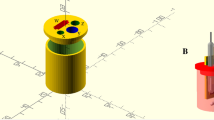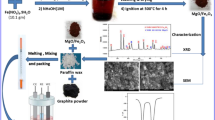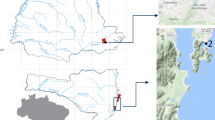Abstract
In this work, a boron-doped diamond (BDD) electrode was evaluated for the electroanalytical determination of millimolar concentrations of Cu2+, Fe2+ and Fe3+ using chronoamperometry. The interfering role that each ion plays on the quantitative determination of other metal ion concentrations was also assessed. No interference from other metal ions was observed when Fe3+ and Fe2+ were analysed. By contrast, reduction of Fe3+ took place at the same potential where [Cu2+] was measured causing a minor interference to the Cu2+ signal. A multiple linear regression (MLR) calibration model was made for each analyte using real bioleaching samples, which demonstrated high coefficients of determination and adequate standard errors. The methods developed were used to monitor bioleaching of chalcopyrite for 4 months. The electroanalytical methods are particularly well-suited for analysing Cu2+, Fe3+ and Fe2+ concentration in acidic mine drainage (AMD) and bioleaching environments.








Similar content being viewed by others
References
Akcil A, Koldas S (2006) Acid mine drainage (AMD): causes, treatment and case studies. J Clean Prod 14:1139–1145
Johnson DB, Hallberg KB (2005) Acid mine drainage remediation options: a review. Sci Total Environ 338:3–14
Sheoran AS, Sheoran V (2006) Heavy metal removal mechanism of acid mine drainage in wetlands: a critical review. Minerals Eng 19:105–116
Malmqvist B, Hoffsten P (1999) Influence of drainage from old mine deposits on benthic macroinvertebrate communities in central Swedish streams. Water Res 33:2415–2423
Sasaki A, Ito A, Aizawa J, Umita T (2005) Influence of water and sediment quality on benthic biota in an acidified river. Water Res 39:2517–2526
Hallberg KB (2010) New perspectives in acid mine drainage microbiology. Hydrometallurgy 104:448–453
Pradhan N, Nathsarma KC, Srinivasa Rao K, Sukla LB, Mishra BK (2008) Heap bioleaching of chalcopyrite: a review. Minerals Eng 21:355–365
Leahy MJ, Schwarz MP (2009) Modelling jarosite precipitation in isothermal chalcopyrite bioleaching columns. Hydrometallurgy 98:181–191
Zhang Y, Qin W, Wang J, Zhen S, Yang C, Zhang J, Nai S, Qiu T (2008) Bioleaching of chalcopyrite by pure and mixed culture. Trans Nonferrous Metal Soc 18:1491–1496
Zhao X, Wang R, Lu X, Lu J, Li C, Li J (2013) Bioleaching of chalcopyrite by Acidithiobacillus ferrooxidans. Minerals Eng 53:184–192
Vilcáez J, Suto K, Inoue C (2008) Bioleaching of chalcopyrite with thermophiles: temperature–pH–ORP dependence. Int J Miner Process 88:37–44
Hulanicki A, vel Krawczyk TK (1987) Behaviour of a chalcocite copper ion-selective electrode in solutions of iron(III) ions. Talanta 34:407–410
Radić N, Vudrag M (1984) Kinetic determination of iron(III) with a copper(II) selective electrode based on a metal displacement reaction. J Electroanal Chem Interfacial Electrochem 178:321–327
Jung H, Yun S, Kwon J, Zheng Y (2012) Role of iron colloids in copper speciation during neutralization in a coastal acid mine drainage, South Korea: insight from voltammetric analyses and surface complexation modeling. J Geochem Explor 112:244–251
Honório GG, Azevedo GC, Matos MAC, de Oliveira MAL, Matos RC (2014) Use of boron-doped diamond electrode pre-treated cathodically for the determination of trace metals in honey by differential pulse voltammetry. Food Control 36:42–48
Martin HB, Argoitia A, Landau U, Anderson AB, Angus JC (1996) Hydrogen and Oxygen Evolution on Boron Doped Diamond Electrodes. J Electrochem Soc 143:133–136
Ramesham R, Rose MF (1997) Electrochemical characterization of doped and undoped CVD diamond deposited by microwave plasma. Diam Relat Mater 6:17–26
Ivandini TA, Sato R, Makide Y, Fujishima A, Einaga Y (2004) Electroanalytical application of modified diamond electrodes. Diam Relat Mater 13:2003–2008
Einaga Y, Sato R, Olivia H, Shin D, Ivandini TA, Fujishima A (2004) Modified diamond electrodes for electrolysis and electroanalysis applications. Electrochim Acta 49:3989–3995
Sonthalia P, McGaw E, Show Y, Swain GM (2004) Metal ion analysis in contaminated water samples using anodic stripping voltammetry and a nanocrystalline diamond thin-film electrode. Anal Chim Acta 522:35–44
Dragoe D, Spătaru N, Kawasaki R, Manivannan A, Spătaru T, Tryk DA, Fujishima A (2006) Detection of trace levels of Pb2+ in tap water at boron-doped diamond electrodes with anodic stripping voltammetry. Electrochim Acta 51:2437–2441
Salimi A, Alizadeh V, Hallaj R (2006) Amperometric detection of ultra trace amounts of Hg(I) at the surface boron doped diamond electrode modified with iridium oxide. Talanta 68:1610–1616
Manivannan A, Kawasaki R, Tryk DA, Fujishima A (2004) Interaction of Pb and Cd during anodic stripping voltammetric analysis at boron-doped diamond electrodes. Electrochim Acta 49:3313–3318
Tan SN, Chen M (2012) Early stage adsorption behaviour of Acidithiobacillus ferrooxidans on minerals I: an experimental approach. Hydrometallurgy 119–120:87–94
Ni Y, Li S, Kokot S (2011) Simultaneous voltammetric analysis of tetracycline antibiotics in foods. Food Chem 124:1157–1163
Turnes G, Cladera A, Gómez E, Estela JM, Cerdà V (1992) Resolution of highly overlapped differential pulse polarographic and anodic stripping voltammetric peaks by multicomponent analysis. J Electroanal Chem 338:49–60
Cladera A, Alpízar J, Estela JM, Cerdà V, Catasús M, Lastres E, García L (1997) Resolution of highly overlapping differential pulse anodic stripping voltammetric signals using multicomponent analysis and neural networks. Anal Chim Acta 350:163–169
Vazquez-Arenas J, Vázquez G, Meléndez AM, González I (2007) The Effect of the Cu2+/Cu+ Step on Copper Electrocrystallization in Acid Noncomplexing Electrolytes. J Electrochem Soc 154:473–481
Couto AB, Santos LCD, Matsushima JT, Baldan MR, Ferreira NG (2011) Hydrogen and oxygen plasma enhancement in the Cu electrodeposition and consolidation processes on BDD electrode applied to nitrate reduction. Appl Surf Sci 257:10141–10146
Volov I, Saito T, West AC (2011) Investigation of Copper Plating and Additive Interactions in the Presence of Fe3+/Fe2+ Redox Couple. J Electrochem Soc 158:384–389
Khouraibchia Y, Moats MS (2010) Evaluation of the Effect of Copper Electrowinning Parameters on Current Efficiency and Energy Consumption Using Surface Response Methodology. ECS Trans 28:295–306
Jin X, Botte G (2009) Electrochemical technique to measure Fe(II) and Fe(III) concentrations simultaneously. J Appl Electrochem 39:1709–1717
Zhang Y, Yoshihara S (2004) Cathodic stripping voltammetry of nickel on boron-doped diamond. J Electroanal Chem 573:327–331
Hoffmann R, Kriele A, Obloh H, Hees J, Wolfer M, Smirnov W, et al. (2010) Electrochemical hydrogen termination of boron-doped diamond. Appl Phys Lett 97:052103,052103-3
Szunerits S, Boukherroub R (2008) Different strategies for functionalization of diamond surfaces. J Solid State Electro 12:1205–1218
Ribeiro MC, Silva LGd, Sumodjo PTA (2006) The influence of electrochemical pre-treatment of B-doped diamond films on the electrodeposition of Pt. J Brazil Chem Soc 17:667–673
Acknowledgments
The authors would like to acknowledge the financial support received from the CSIRO Office of the Chief Executive. Discussions with Professor Roger Horn, Dr David Nairn, Mike Horne and Dr Jean-Pierre Veder are appreciated.
Author information
Authors and Affiliations
Corresponding author
Rights and permissions
About this article
Cite this article
Vepsäläinen, M., Chen, M., Yang, Y. et al. Cu2+, Fe2+ and Fe3+ analysis of bioleaching solutions using chronoamperometry and BDD electrode. J Appl Electrochem 44, 1135–1143 (2014). https://doi.org/10.1007/s10800-014-0739-2
Received:
Accepted:
Published:
Issue Date:
DOI: https://doi.org/10.1007/s10800-014-0739-2




